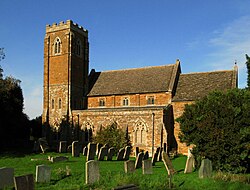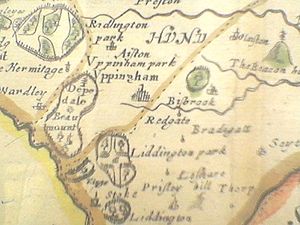Bisbrooke
| Bisbrooke | |
| Rutland | |
|---|---|
 St John the Baptist Church | |
| Location | |
| Grid reference: | SP886996 |
| Location: | 52°35’24"N, -0°41’24"W |
| Data | |
| Population: | 211 (2001[1]) |
| Post town: | Oakham |
| Postcode: | LE15 |
| Dialling code: | 01572 |
| Local Government | |
| Council: | Rutland |
| Parliamentary constituency: |
Rutland and Melton |
Bisbrooke is a village and parish in the county of Rutland. It is situated about two miles east of Uppingham close to the A47 road. In 2001, it had a population of 219, falling to 204 at the 2011 census.[2]
History

Bisbrooke was first recorded in the Domesday Book of 1086 then spelt "Bitlesbroch". Over the centuries the spelling has gone through as many as 19 name changes including Bitelesbroke, Pysbroke and Butlisbroke before the present spelling was adopted. At the time of the Norman survey, about half of the land was owned by the King and the rest by Countess Judith of Fotheringhay in Northamptonshire. Following the dissolution of the monasteries in the sixteenth century, in 1547 the land was granted by King Edward VI to Sir Richard Lee who soon afterwards settled it on Anthony Andrews. The land was still in the Andrews family nearly a century later with Bisbrooke or Pisbroke as it was then spelled, being owned by Anthony’s great, grandson Edward, Sheriff of Rutland. In the Civil War Edward initially supported the King but afterwards embraced the Parliamentarians’ cause. Fined for his earlier Royalist tendencies, he seemed to have been unable to meet his debts and his land was sold. The Bisbrooke estate was acquired during the Commonwealth by Sir George Manners and so, most of Bisbrooke passed into the Duke of Rutland’s Belvoir Estate. It was auctioned in 1918.
Notable buildings
The parish church of St John the Baptist dates from 1871 in its present form, though the tower was only finished in 1914. It was listed Grade II in 1955.[3] There are a number of fine gravestones,[4] which pre-date the present building. Samuel Thomas Bloomfield was vicar here from 1814 until his death in 1869.
The village pub, the Gate was run by Ruby D'Arcy[5] from 1968 to 2012 and many a schoolboy from Uppingham School (Stephen Fry, Rick Stein, Jonathan Agnew, David Whitaker and Johnny Vaughan among them) supposedly slipped across the fields from Uppingham to relax, away from their masters' watchful gaze. Ruby's husband Peter D'Arcy was spoken of with affection and when he died, 1,500 mourners attended his funeral in Bisbrooke church.
Bisbrooke Hall is to the north of the A47 within the parish boundary but actually nearer to the village of Glaston. The Hall was substantially remodelled and extended by Lord Carbery around 1840.
In the 1950s, "small-holdings, orchards and vegetable patches jostle each other in the sheltered hollows of Bisbrooke” where “almost everyone grows and sells strawberries”; much of the fruit was sent for jam-making.
The village was too unremarkable to warrant an entry in Arthur Mee's The King's England volume.
References
- ↑ "Rutland Civil Parish Populations". Rutland County Council. 2001. http://www.rutland.gov.uk/ppimageupload/Image27657.PDF. Retrieved 30 January 2009.
- ↑ "Civil Parish population 2011". Neighbourhood Statistics. Office for National Statistics. http://www.neighbourhood.statistics.gov.uk/dissemination/LeadKeyFigures.do?a=7&b=11120755&c=bisbrooke&d=16&e=62&g=6384750&i=1001x1003x1032x1004&m=0&r=1&s=1466764491736&enc=1. Retrieved 24 June 2016.
- ↑ National Heritage List 1116350: Church of St John the Baptist
- ↑ National Heritage List 1073684: Headstone to Nathaniel Clark
- ↑ Obituary Ruby D'Arcy" Stamford Mercury, 24 April 2012
Outside links
| ("Wikimedia Commons" has material about Bisbrooke) |
